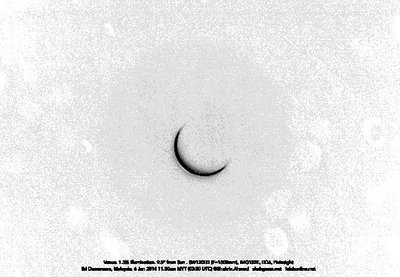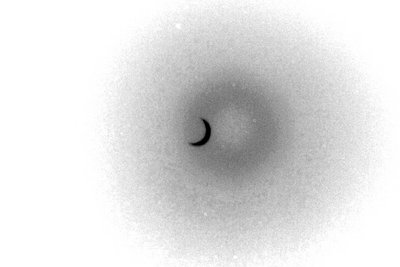by alter-ego » Tue Jan 07, 2014 5:11 am
Anthony Barreiro wrote:
...
When I look at the full resolution version of
this image I see a very faint band of light extending almost all the way around Venus' dark limb. The very points of the illuminated crescent also look slightly fuzzy, rather than as sharply defined as the rest of the crescent. What could cause these effects other than sunlight shining through Venus' atmosphere?
Anthony, although I see a suggestion of a tenuous limb outline, I believe it is an artifact of our brain completing the circle and/or artifacts of the image. To me, the edge is ill-defined and comes and goes depending how I look at it (zoom changes included). One obvious background non-uniformity is a broad halo to the right of Venus.
Below is a better comparative image. It has a similar blue sky but sharper image and much better background uniformity. Also Venus has a 9.5° elongation here compared to the larger 14
+° elongation in the APOD. I'd expect better dark-side limb visibility for the image below:
Universe Today
It is interesting that I can convince myself that I see a similar circular edge here too, but viewing an enhanced contrast, BW negative of the image, the apparent circular ring goes away:

- Image negative, contrast enhanced
Below is a similar enhancement of the higher resolution image from your link:

- Higher-resolution (link) negative, contrast enhanced (note, halo forced a significantly reduced enhancement factor)
Bottom line is, I think the edge you are seeing is a manifestation of our brain and image background non-uniformity.
[quote="Anthony Barreiro"]
...
When I look at the full resolution version of [url=http://spaceweathergallery.com/indiv_upload.php?upload_id=92366]this image[/url] I see a very faint band of light extending almost all the way around Venus' dark limb. The very points of the illuminated crescent also look slightly fuzzy, rather than as sharply defined as the rest of the crescent. What could cause these effects other than sunlight shining through Venus' atmosphere?[/quote]
Anthony, although I see a suggestion of a tenuous limb outline, I believe it is an artifact of our brain completing the circle and/or artifacts of the image. To me, the edge is ill-defined and comes and goes depending how I look at it (zoom changes included). One obvious background non-uniformity is a broad halo to the right of Venus.
Below is a better comparative image. It has a similar blue sky but sharper image and much better background uniformity. Also Venus has a 9.5° elongation here compared to the larger 14[sup]+[/sup]° elongation in the APOD. I'd expect better dark-side limb visibility for the image below:
[url=http://d1jqu7g1y74ds1.cloudfront.net/wp-content/uploads/2014/01/venus6Jan2014_1130amMYT.png][size=130][i]Universe Today[/i][/size][/url]
[img2]http://d1jqu7g1y74ds1.cloudfront.net/wp-content/uploads/2014/01/venus6Jan2014_1130amMYT.png[/img2]
It is interesting that I can convince myself that I see a similar circular edge here too, but viewing an enhanced contrast, BW negative of the image, the apparent circular ring goes away:
[attachment=1]venus6Jan2014_1130amMYT-580x401_N.jpg[/attachment]
Below is a similar enhancement of the higher resolution image from your link:
[attachment=0]Steven-Bellavia-Venus_01-04-2014_Celestron_C5_2X-Barlow_Canon_EOS_T3_ISO_400_250th_sec_IMG_8404_reduced_size_1388863251_lg_N.jpg[/attachment]
Bottom line is, I think the edge you are seeing is a manifestation of our brain and image background non-uniformity.